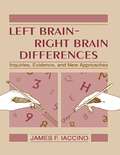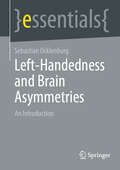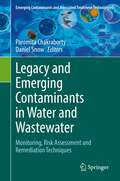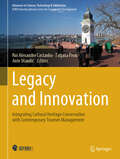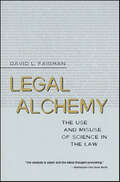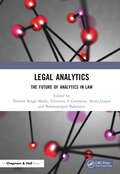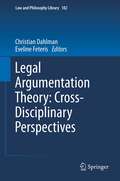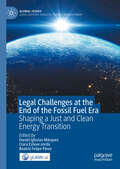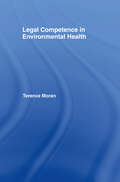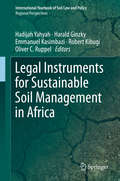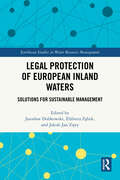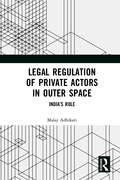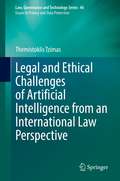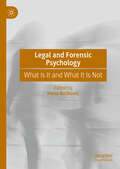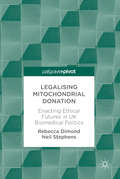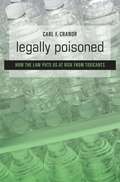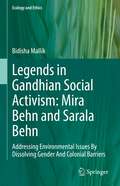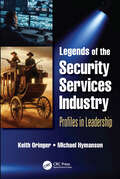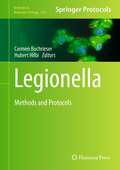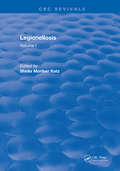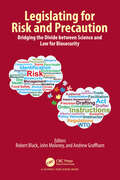- Table View
- List View
Left Brain - Right Brain Differences: Inquiries, Evidence, and New Approaches
by James F. IaccinoThis volume integrates past clinical findings with the latest research on cerebral asymmetry in order to identify why humans process information in different ways. A must for anyone who wants to understand human cognitive nature further, specifically the reasons why we are "wired" a certain way and whether these cortical circuits are flexible enough to be altered, this book presents the most up-to-date information on hemispheric differences within normal and clinical populations. Its focus on sex, handedness, and developmental differences is critical to the derivation of a better perspective on how future research should be conducted in this expanding science. Iaccino begins by explaining basic brain structures and types of cognitive styles assigned to each hemisphere. He then details studies involving various clinical populations -- psychophysiological, split-brain, dyslexic, and psychotic -- to support the claim that the two hemispheres are different, morphologically and functionally speaking. Applying this clinical research to the more normal population, the author uncovers striking cortical variations between the sexes and between the handedness groups, along with developmental changes which occur as a function of time. Finally, he provides a detailed summary of the previous chapters and highlights where asymmetrical research may be headed in the future.
Left-Handedness and Brain Asymmetries: An Introduction (essentials)
by Sebastian OcklenburgThis Springer essential provides an overview of current research on the topic of left-handedness and brain asymmetries. In addition to basics of assessing left-handedness and brain asymmetries, it also explores their evolution, development, and their study in the animal kingdom. Other focal points include research on the relationship between left-handedness and cognitive functions, as well as the topic of handedness and sports. The essential is rounded off with a discussion on the topic of relearning handedness and a discourse on altered asymmetries in various patient groups.
Legacy and Emerging Contaminants in Water and Wastewater: Monitoring, Risk Assessment and Remediation Techniques (Emerging Contaminants and Associated Treatment Technologies)
by Daniel Snow Paromita ChakrabortyThis volume provides a collection of research findings on the distribution and risk associated with emerging contaminants (ECs) in water and wastewater across the globe, and effective remediation techniques and technologies. The book covers various monitoring techniques for ECs in water and wastewater and its related impacts on the ambient environment, and offers valuable information on cost-effective monitoring techniques and sustainable treatment technologies for ECs. The authors detail the risks and biological effects of ECs and legacy persistent organic pollutants (POPs) in freshwater and marine systems, including their adverse interactions with aquatic organisms, while also discussing the associated impacts on human health. The book comprehensively covers current research outcomes on treatment methods, cost-effectiveness, and infrastructure needs for effective removal of ECs. It will be of interest to students, researchers, and scholars in environmental science and engineering, water and wastewater, toxicology, environmental biotechnology, soil sciences, and microbial ecology.
Legacy and Innovation: Integrating Cultural Heritage Conservation with Contemporary Tourism Management (Advances in Science, Technology & Innovation)
by Ante Mandić Rui Alexandre Castanho Tatjana PivacThis book explores the intersection of culture, sustainability, and tourism. Also, it explores the importance of integrating cultural heritage preservation, environmental sustainability, and economic considerations in the development of tourism destinations. It provides a deep understanding of how cultural tourism can be harnessed to create positive and responsible tourism experiences that benefit local communities, protect natural resources, and promote cultural diversity. Drawing upon real-world examples and case studies, this book offers practical strategies and approaches for fostering sustainable tourism practices. It examines the role of technology in enhancing cultural tourism experiences, the impact of tourism on local economies, and the preservation of cultural vitality in peripheral areas. The book also analyzes the implications of the Covid-19 pandemic on the tourism industry and explores sustainable development models for the post-pandemic era. With a multidisciplinary approach, this book is a valuable resource for tourism professionals, policymakers, researchers, and students interested in the field of sustainable tourism. It emphasizes the need for a balanced and holistic approach that considers the social, environmental, and economic dimensions of cultural tourism. By promoting cultural understanding, environmental stewardship, and inclusive community engagement, "Cultural Sustainable Tourism" paves the way for a more sustainable and responsible future in the tourism industry. This book provides a diverse range of case studies and research insights into various aspects of sustainable tourism. It offers valuable perspectives on community-based approaches, cultural preservation, the impact of the Covid-19 pandemic, destination modeling, heritage restoration, and the interconnections between tourism, media, and culture. Throughout the book, readers will find a wealth of case studies, research insights, and practical examples from around the world. These real-world examples offer valuable lessons and best practices for implementing sustainable cultural tourism initiatives. The book also encourages critical thinking and reflection, inviting readers to consider the ethical dimensions of cultural tourism, the importance of local empowerment, and the long-term sustainability of tourism practices.
Legal Alchemy: The Use and Misuse of Science in the Law
by David L. FaigmanIs scientific information misused by this country's court system and lawmakers? Today more than ever before, lawyers, politicians, and government administrators are forced to wrestle with scientific research and to employ scientific thinking. The results are often less than enlightened.In Legal Alchemy, David Faigman explores the ways the American legal system incorporates scientific knowledge into its decision making. Praised by both legal and scientific communities when it first appeared in hardcover, Legal Alchemy shows how science has been used and misused in a variety of settings, including• The Courtroom—from the O. J. Simpson trial to the Dow Corning silicone breast implant lawsuit to landmark cases such as Roe v. Wade. • The Legislature—where Congress uses scientific information to help enact legislation about clean air, cloning, and government science projects like the space station and the superconducting super collider. • Government Agencies—who use science to determine policy on a variety of topics, from regulating sport utility vehicles to reintroducing gray wolves to Yellowstone National Park. As Faigman describes these and other important cases, he provides disturbing evidence that many judges, juries, and members of Congress simply don't understand the science behind their decisions. Finally, he offers suggestions on how the science and legal professions can overcome their miscommunication and work together more effectively.
Legal Analytics: The Future of Analytics in Law
by Namita Singh Malik, Elizaveta A Gromova, Smita Gupta and Balamurugan BalusamyLegal Analytics: The Future of Analytics in Law navigates the crisscrossing of intelligent technology and legal field in building up new landscape of transformation. Legal automation navigation is multidimensional wherein it intends to construct streamline communication, approval and management of legal task. Evolving environment of technology has emphasized need for better automations in legal field from time to time. Although legal scholars took long to embrace Information revolution of legal field. •Describes the historical development of law and automation •Analyses the challenges and opportunities in law and automation •Studies the current research and development in the convergence of Law, Artificial Intelligence and Legal Analytics •Explores the recent emerging trends and technologies that are used by various legal System globally for Crime Prediction & Prevention •Examines the applicability of legal analytics in forensic investigation •Investigates the impact of legal analytics tools and techniques in judicial decision making •Analyses deep learning techniques and its scope in accelerating legal analytics in developed and developing countries • Provides the in-depth analysis of implementation, challenges and issues in the society related to legal analytics The book is primarily aimed at graduates, postgraduates in law & technology, computer science and information technology. Legal practitioners and academicians will also find this book helpful.
Legal Argumentation Theory: Cross-Disciplinary Perspectives
by Christian Dahlman Eveline FeterisThis book offers its readers an overview of recent developments in the theory of legal argumentation written by representatives from various disciplines, including argumentation theory, philosophy of law, logic and artificial intelligence. It presents an overview of contributions representative of different academic and legal cultures, and different continents and countries. The book contains contributions on strategic maneuvering, argumentum ad absurdum, argumentum ad hominem, consequentialist argumentation, weighing and balancing, the relation between legal argumentation and truth, the distinction between the context of discovery and context of justification, and the role of constitutive and regulative rules in legal argumentation. It is based on a selection of papers that were presented in the special workshop on Legal Argumentation organized at the 25th IVR World Congress for Philosophy of Law and Social Philosophy held 15-20 August 2011 in Frankfurt, Germany.
Legal Aspects Around Satellite Constellations: Volume 2 (Studies in Space Policy #31)
by Annette FroehlichThis book is the highly anticipated sequel to the previous volume under the same title, dedicated to presenting a diverse range of timely and valuable contributions on the legal and policy related questions evoked by satellite constellations, including emerging mega-constellations. Given the proliferation of activities in the field of satellite constellations, and the critical roles they play in supporting and enabling communication, navigation, disaster monitoring, Earth observation, security and scientific activities, the insights of legal and policy experts from around the world have been gathered in this second volume to help expand the scientific literature in this precious field. Topics range from legal obstacles and opportunities facilitating small satellite enterprise for emerging space actors, international cooperation in the compatibility and interoperability of navigation systems, the designation of satellite constellations as critical space infrastructure, to an analysis of the paradigm shift which has occurred over the last decade to make the proliferation of small satellite constellations possible, and more.
Legal Aspects of Implementing the Cartagena Protocol on Biosafety
by Marie-Claire Cordonier Segger Frederic Perron-Welch Christine FrisonThis book, the first in a new series that focuses on treaty implementation for sustainable development, examines key legal aspects of implementing the Cartagena Protocol on Biosafety to the UN Convention on Biological Diversity (CBD) at national and international levels. The volume provides a serious contribution to the current legal and political academic debates on biosafety by discussing key issues under the Cartagena Protocol on Biosafety that affect the further design of national and international law on biosafety, and analyzing recent progress in the development of domestic regulatory regimes for biosafety. It also examines the legal, political, economic, and practical challenges and solutions encountered in recent efforts to develop and implement domestic biosafety regulations, with a focus on developing countries. In the year of the fifth UN Meeting of the Parties to the Cartagena Protocol on Biosafety, at the signature of a new Nagoya-Kuala Lumpur Protocol on Liability and Redress, this timely book examines recent developments in biosafety law and policy.
Legal Challenges at the End of the Fossil Fuel Era: Shaping a Just and Clean Energy Transition (Global Issues)
by Daniel Iglesias Márquez Clara Esteve-Jordà Beatriz Felipe PérezThis edited collection proposes a wide range of approaches to address the legal issues pertaining to the end of the fossil fuel era. While the fossil fuel era is coming to an end both because of the inherent limits of its resources and because of the need to prevent to further pump out CO2 in an already saturated atmosphere, the legal dispositions to ensure an ordered and rational shift toward cleaner energy still need to be developed. Not only in relation to CO2 emissions themselves but also in relation to the manifold issues related to environmental justice in an era of global climate change and global warming. This book is unique in that it provides a theoretical framework but also works to address cutting edge issues through a series of case studies.
Legal Competence in Environmental Health
by Terence MoranLegal Competence in Environmental Health assists the environmental health professional in understanding the operation of English law and navigating through some of its complexities. It covers those aspects of the work which are regulated by legal principles but not found in a single statute.
Legal Instruments for Sustainable Soil Management in Africa (International Yearbook of Soil Law and Policy)
by Harald Ginzky Oliver C. Ruppel Emmanuel Kasimbazi Hadijah Yahyah Robert KibugiThis book presents an important discussion on future options for sustainable soil management in Africa from various perspectives, including national soil protection regulations, the role of tenure rights, the work of relevant international institutions such as the UNCCD and FAO, and regional and international cooperation. This first volume of the new subseries Regional Perspectives to the International Yearbook of Soil Law and Policy includes contributions by African and international experts alike. Given the range of key topics covered, the book offers an indispensable tool for all academics, legislators and policymakers working in this field. The “International Yearbook of Soil Law and Policy – Regional Perspectives” series discusses central questions in law and politics that concern the protection and sustainable management of soil and land in different regions of the world.
Legal Protection of European Inland Waters: Solutions for Sustainable Management (Earthscan Studies in Water Resource Management)
by Jarosław Dobkowski Elżbieta Zębek Jakub Jan ZiętyThis book examines the legal protection and management of inland waters in Europe.With inland waters facing a range of significant threats, including from climate change, pollution, and overexploitation, this volume discusses legal solutions for protecting and managing these inland waters. It presents comparative studies from a range of European countries, including the Czech Republic, Germany, France, Lithuania, Poland, and Spain, with each chapter examining the legal status and legal instruments being implemented in each country, allowing for easy cross-comparison. Topics covered include surface water management and protection, water quality and monitoring, management of hazardous substances, and crisis management. Through these unique comparative studies, the volume highlights legal solutions which can be adopted by other nations and used as models for wider implementation across Europe. In doing so, this book offers important recommendations for changing water law to ensure a water secure future in Europe.This book will be of great interest to students and scholars of water law, water resource management, environmental policy, and environmental conservation.
Legal Regulation of Private Actors in Outer Space: India’s Role
by Malay AdhikariThe book addresses legal issues and challenges in using Space Technology. Especially covered are the provisions of International Space Law and few national space legislations to regulate private actors in outer space. The key chapters covered are history of space regulations, private actors in space, legal issues for such actors, regulating these issues outside India, and the same in India. In concluding chapter, the author has worked out some recommendations.The book would be of immense use to people especially startups in private space industry; students, faculties and scholars of Space Law and Policy, Space Security, Defence and Security Studies.Please note: Taylor & Francis does not sell or distribute the Hardback in India, Pakistan, Nepal, Bhutan, Bangladesh and Sri Lanka
Legal and Ethical Challenges of Artificial Intelligence from an International Law Perspective (Law, Governance and Technology Series #46)
by Themistoklis TzimasThis book focuses on the legal regulation, mainly from an international law perspective, of autonomous artificial intelligence systems, of their creations, as well as of the interaction of human and artificial intelligence. It examines critical questions regarding both the ontology of autonomous AI systems and the legal implications: what constitutes an autonomous AI system and what are its unique characteristics? How do they interact with humans? What would be the implications of combined artificial and human intelligence? It also explores potentially the most important questions: what are the implications of these developments for collective security –from both a state-centered and a human perspective, as well as for legal systems? Why is international law better positioned to make such determinations and to create a universal framework for this new type of legal personality? How can the matrix of obligations and rights of this new legal personality be construed and what would be the repercussions for the international community? In order to address these questions, the book discusses cognitive aspects embedded in the framework of law, offering insights based on both de lege lata and de lege ferenda perspectives.
Legal and Forensic Medicine
by Roy G BeranThis is a comprehensive reference text that examines the current state of Legal Medicine, which encompasses Forensic Medicine, in the 21st century. It examines the scope of both legal and forensic medicine, its application and study and has adopted a wide ranging approach including multinational authorship. It reviews the differences between and similarities of forensic and legal medicine, the need for academic qualification, the applications to many and varied fields including international aid, military medicine, health law and the application of medical knowledge to both criminal law and tort/civil law, sports medicine and law, gender and age related factors from obstetrics through to geriatrics and palliative care as well as cultural differences exploring the Christian/Judeo approach compared with that within Islamic cultures, Buddhism and Hinduism. The book will look at practical applications of legal medicine within various international and intercultural frameworks. This will be a seminal authoritative text in legal and forensic medicine. It has a multi-author and multinational approach which will cross national boundaries. There is a great interest in the development of health law and legal medicine institutes around the world and this text will come in on the ground floor of this burgeoning discipline and will provide the foundation text for many courses, both undergraduate and postgraduate. It will define the place of legal medicine as a specialized discipline.
Legal and Forensic Psychology: What Is It and What It Is Not
by Irena BoškovićThis book seeks to distinguish empirically-based knowledge from widespread misconceptions in the fields of legal and forensic psychology. Across ten chapters, leading scholars contribute different perspectives on their areas of expertise within the fields of legal and forensic psychology, providing a comprehensive overview of the historical context and defining characteristics of these two disciplines. The first section of the book is dedicated to legal psychology, exploring issues such as pseudoscience in lie detection, the use of polygraphs, and the reliability of eyewitness testimony and memory reports in legal settings. The second focuses on forensic psychology, addressing topics such as the relationship between criminal behavior and psychopathology, symptom validity assessment, risk assessment, and the treatment of forensic patients. As such, this vital book will serve as an excellent starting point for those seeking to educate themselves about these disciplines.
Legalising Mitochondrial Donation: Enacting Ethical Futures In Uk Biomedical Politics
by Rebecca Dimond Neil StephensIn 2015 the UK became the first country in the world to legalise mitochondrial donation, a controversial germ line reproductive technology to prevent the transmission of mitochondrial disease. Dimond and Stephens track the intense period of scientific and ethical review, public consultation and parliamentary debates preceeding the decision. They draw on stakeholder accounts and public documents to explore how patients, professionals, institutions and publics mobilised within ‘for’ and ‘against’ clusters, engaging in extensive promissory, emotional, bureaucratic, ethical, embodied and clinical labour to justify competing visions of an ethical future. They describe how this decision is the latest iteration of a UK sociotechnical imaginary in which the further liberalization of human embryo research and use is rendered legitimate and ethical through modes of consultation and permissive but strictly regulated licensing. Overall, this book presents a timely, multi-dimensional, and sociological account of a globally significant landmark in the history of human genetics, and will be relevant to those with an interest in genetics, Science, Technology and Society, the sociology of medicine, reproductive technology, and public policy debate.
Legally Poisoned: How the Law Puts Us at Risk from Toxicants
by Carl F. CranorTake a random walk through your life and you’ll find it is awash in industrial, often toxic, chemicals. Sip water from a plastic bottle and ingest bisphenol A. Prepare dinner in a non-stick frying pan or wear a layer of Gore-Tex only to be exposed to perfluorinated compounds. Hang curtains, clip your baby into a car seat, watch television—all are manufactured with brominated flame-retardants. Cosmetic ingredients, industrial chemicals, pesticides, and other compounds enter our bodies and remain briefly or permanently. Far too many suspected toxic hazards are unleashed every day that affect the development and function of our brain, immune system, reproductive organs, or hormones. But no public health law requires product testing of most chemical compounds before they enter the market. If products are deemed dangerous, toxicants must be forcibly reduced or removed—but only after harm has been done. In this scientifically rigorous legal analysis, Carl Cranor argues that just as pharmaceuticals and pesticides cannot be sold without pre-market testing, other chemical products should be subject to the same safety measures. Cranor shows, in terrifying detail, what risks we run, and that it is entirely possible to design a less dangerous commercial world.
Legends in Gandhian Social Activism: Addressing Environmental Issues By Dissolving Gender And Colonial Barriers (Ecology and Ethics)
by Bidisha MallikThis book is about Madeleine Slade (1892-1982) and Catherine Mary Heilemann (1901-1982), two English associates of Mohandas K. (Mahatma) Gandhi (1869-1948), known in India as Mira Behn and Sarala Behn. The odysseys of these women present a counternarrative to the forces of imperialism, colonialism, capitalism, and globalized development. The book examines their extraordinary journey to India to work with Gandhi and their roles in India’s independence movement, their spiritual strivings, their independent work in the Himalayas, and most importantly, their contribution to the evolution of Gandhian philosophy of socio-economic reconstruction and environmental conservation in the present Indian state of Uttarakhand. The author shows that these women developed ideas and practices that drew from an extensive intellectual terrain that cannot be limited to Gandhi’s work. She delineates directions in which Gandhian thought and experiments in rural development work and visions of a new society evolved through the lives, activism, and written contributions of these two women. Their thought and practice generated a new cultural consciousness on sustainability that had a key influence in environmental debates in India and beyond and were responsible for two of the most important environmental movements of India and the world: the Chipko Movement or the movement against commercial green felling of trees by hugging them, and the protest against the Tehri high dam on the Bhagirathi River. To this day, their teachings and philosophies constitute a useful and significant contribution to the search for and implementation of global ideas of ecological conservation and human development.
Legends of the Security Services Industry: Profiles in Leadership
by Keith Oringer Michael HymansonThe global contract security market now totals over $200 billion, with the number of private security officers exceeding that of public law enforcement officers. But this wasn’t always the case.Legends of the Security Services Industry: Profiles in Leadership presents the unique stories of 15 industry legends, who transformed the industry from early private detective and small night watch companies into large-scale contract security companies. The large-scale companies include, but are not limited to, Pinkerton, Burns International, The Wackenhut Corporation, Guardsmark, Wells Fargo, and U.S. Security Associates; as well as today’s leading security companies, Allied Universal, Securitas, G4S, Prosegur, and GardaWorld.The book begins in the nineteenth century, with early U.S. legendary detectives: Allan Pinkerton and William Burns. Then, the book focuses largely from the mid-twentieth century to the present, where successive generations of legends built large-scale contract security companies which competed with, and then acquired, those formed by the early legends. Part II legends George Wackenhut, Ira Lipman, and Tom Wathen; Part III legends, Charles Schneider, Kenneth W. Oringer, William Whitmore, Jr., and Albert Berger; and Part IV, Scandinavian legends Jørgen Philip-Sørensen, Lars Nørby Johansen, and Thomas Berglund, all developed major security companies. Part V includes current global security leaders Helena Revoredo Gut, Stephan Crétier, and Steve Jones. Part VI reviews the timelines and successful leadership of these legendary leaders, with a look at the future of the industry.The legends’ personal stories contain colorful insight into how they capitalized on the industry’s explosive growth. While each generation of legends faced unique social and competitive landscapes, their personal stories illustrate how they respectively succeeded. Their leadership and management prowess enabled them to achieve great success, as they displayed vision and achieved their goals through grit, determination, hard work, charisma, organizational skills, and calculated risk-taking.Each chapter has been extensively researched and includes firsthand accounts based on interviews with living legends, colleagues, and family of deceased legends. Personal, company and signature event photos add further color to the moving narrative. Their stories are not only highly interesting, but also provide a framework for current leaders, and the next generation of entrepreneurs, on how to build and lead large-scale security service companies. With a Foreword from Robert D. McCrie, PhD, longtime John Jay Professor and editor of the renowned industry publication The Security Letter.
Legionella
by Carmen Buchrieser Hubert HilbiThis Methods in Molecular BiologyTM series book presents methods specifically adapted and developed for the study of distinct features of L. pneumophila. Includes materials lists, reproducible protocols, and notes on troubleshooting and pitfalls.
Legionellosis: Volume I
by KatzLegionellosis is a text in two volumes that presents the modern viewpoint of the agent and the disease. It also chronicles the history of the discovery of Legionella pneumophila. Volume 1 discusses current aspects of the microbe including taxonomy, morphology, biochemistry, and physiology. It also discusses the illness including clinical features, pathology, and therapy. Volume II details the laboratory diagnosis, epidemiology, and pathology. The contributors are amongst the most eminent scientists in their respective fields.
Legionellosis: Volume II
by KatzLegionellosis is a text in two volumes that presents the modern viewpoint of the agent and the disease. It also chronicles the history of the discovery of Legionella pneumophila. Volume 1 discusses current aspects of the microbe including taxonomy, morphology, biochemistry, and physiology. It also discusses the illness including clinical features, pathology, and therapy. Volume II details the laboratory diagnosis, epidemiology, and pathology. The contributors are amongst the most eminent scientists in their respective fields.
Legislating for Risk and Precaution: Bridging the Divide between Science and Law for Biosecurity
by Robert Black John Moloney Andrew GraffhamThis book aims to demystify the law for scientists and instructing officials by exploring the science and legal concepts of risk and precaution for national legislation to facilitate safe trade in agricultural products (in compliance with international trade rules).The book is not meant to supplant the many authoritative titles on legislative drafting, but provide some practical exercises on instructions and drafting for this area of law. The book also includes some important factors in legal reform, such as the audience for and access to legislation. It, therefore, has the potential to be a valuable resource for coordinated training of instructors and drafters by helping to secure a robust two-way dialogue between them.
